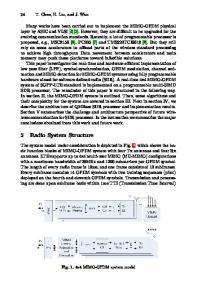Programmable Skins based on Core-Shell Microsphere/Nanotube/Polymer Composites
- PDF / 707,884 Bytes
- 6 Pages / 612 x 792 pts (letter) Page_size
- 85 Downloads / 275 Views
Programmable Skins based on Core-Shell Microsphere/Nanotube/Polymer Composites Balaji Panchapakesan1, Cagdas Onal2 and James Loomis3 1
Small Systems Laboratory, Department of Mechanical Engineering, Worcester Polytechnic Institute, Worcester, MA 01609, USA. 2
Soft Robotics Laboratory, Department of Mechanical Engineering, Robotics Engineering Program, Worcester Polytechnic Institute, Worcester, MA 01609, USA. 3
Department of Mechanical Engineering, Massachusetts Institute of Technology, Cambridge, MA02139, USA. ABSTRACT In this paper, we describe unique thermally responsive polymer system based on nanotube-elastomers dispersed with core-shell expanding microspheres (phase-change material). Upon thermal or infrared stimuli, liquid hydrocarbon cores encapsulated within the microspheres vaporize, expanding the surrounding shells and stretching the matrix. Microsphere transformation resulted in visible dimensional changes associated with macroscopic volume increase (>500%), reduction in density (>80%), and increase in elastic modulus (>675%). Additionally, electrically conductive nanotubes allowed for expansion dependent electrical responses. We present our new findings on expansion dependent superhydrophobicity in these materials and present some outlook and comparison of our stimuli responsive polymers with other material systems for future origami based applications. INTRODUCTION For some materials, energy from an external source can trigger changes in the internal equilibrium state of the structure leading to mechanical responses much larger than the initial input 1. The ability to unlock this internal work in solid state structures is of crucial importance to developing Programmable Materials. Programmable matter is an important and unexplored area for developing future smart materials, devices and systems for wide ranging applications. There are two key philosophies in developing programmable matter. The first one is the use of already existing actuation technologies (ex. shape memory alloys/polymers) in the form of an array and programming the external stimulus to achieve desired shape and form2, 3. The second philosophy is the ability to engineer and program the material itself to external stimuli useful for controlled bending 4-6. The development of materials that can adapt to their surroundings by changing their physical properties is a current challenge in materials engineering 7-10. There are significant challenges to creating such materials with large changes in their material response through a set of material interfaces at the macroscopic, microscopic, mesoscopic and nanoscopic scales all working together. Stimuli responsive composites that exhibit macroscopic changes in shape, dimensions, density, conductivity, elastic modulus, and volume are still in its infancy and ideal for developing programmable matter and could be useful in variety of sensing, adaptive surfaces, actuation, microfluidics, flexible electronics and origami applications. EXPERIMENTAL Thermally Expanding Microspheres (TEMs) (Expancel
Data Loading...











